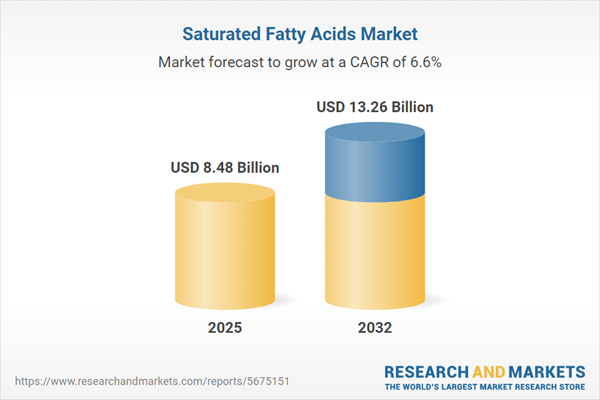Speak directly to the analyst to clarify any post sales queries you may have.
The saturated fatty acids market is undergoing fundamental change as applications shift and stakeholder priorities evolve. Growing demand across industrial, food, pharmaceutical, and personal care sectors underscores the strategic importance for businesses navigating supply chain and regulatory complexities.
Market Snapshot: Saturated Fatty Acids Market Size and Growth
The saturated fatty acids market grew from USD 7.96 billion in 2024 to USD 8.48 billion in 2025. It is forecasted to sustain a CAGR of 6.58%, reaching USD 13.26 billion by 2032.
Scope & Segmentation of the Saturated Fatty Acids Market
This report delivers a detailed analysis of key market segments and regions, including the underlying technologies and value chain participants that determine end-use performance. Segmentation addresses the range of applications, product types, and channels that drive buyer decisions and market strategies.
- Type: Capric Acid, Caprylic Acid, Lauric Acid, Myristic Acid, Palmitic Acid, Stearic Acid
- Form: Liquid, Solid
- Function: Carrier Agent, Emulsifier, Stabilizer, Surfactant
- Distribution Channel: Offline (with a specific focus on Wholesalers), Online
- Application: Animal Feed (including Aquaculture, Poultry, Ruminant, Swine), Cosmetics and Personal Care (Hair Care, Makeup, Oral Care, Skin Care), Food and Beverage (Bakery and Confectionery, Beverages, Dairy Products, Snacks and Savory), Nutraceuticals (Dietary Supplements, Functional Foods), Pharmaceuticals
- Region: Americas (United States, Canada, Mexico, Brazil, Argentina, Chile, Colombia, Peru), Europe, Middle East & Africa (United Kingdom, Germany, France, Russia, Italy, Spain, Netherlands, Sweden, Poland, Switzerland, United Arab Emirates, Saudi Arabia, Qatar, Turkey, Israel, South Africa, Nigeria, Egypt, Kenya), Asia-Pacific (China, India, Japan, Australia, South Korea, Indonesia, Thailand, Malaysia, Singapore, Taiwan)
- Key Companies Covered: Wilmar International Limited, BASF SE, Kao Corporation, Croda International Plc, Stepan Company, AAK AB, Kuala Lumpur Kepong Berhad, Godrej Industries Limited, Oleon N.V., IOI Corporation Berhad
Key Takeaways for Decision Makers
- Demand for saturated fatty acids has transitioned from traditional uses towards advanced formulations in food, pharmaceuticals, and personal care, expanding the market's relevance and complexity.
- Regulatory requirements influence sourcing, production, and labeling across all regions, amplifying the need for traceability, compliance, and closer supplier relationships.
- Innovative product development and specialization, particularly for high-purity and premium grade applications, are becoming core strategies for suppliers targeting sensitive end-user sectors.
- Sustainability goals are driving investments in green extraction technologies, circular supply chains, and certification schemes, especially in regions where transparency influences buyer preference.
- Collaboration between suppliers and downstream formulators enables the development of tailored blends with differentiated performance, supporting co-innovation in functional and wellness-driven applications.
Tariff Impact on Sourcing and Competitive Dynamics
The implementation of cumulative United States tariffs in 2025 has realigned sourcing strategies and cost structures throughout the saturated fatty acids sector. Manufacturers adapted by diversifying supplier networks and investing in domestic production facilities, seeking tariff-free access and improved supply security. These changes sparked collaboration with regional distributors, forcing a reassessment of inventory management to remain competitive under the new regime.
Methodology & Data Sources
This research leverages a multi-tiered methodology. Structured interviews with raw material suppliers, manufacturers, formulators, and end-user companies delivered direct market insights. Quantitative surveys captured procurement preferences and product standards. Secondary analysis incorporated regulatory reviews, industry white papers, customs trade flows, patent analysis, and scientific literature. Triangulation ensured accuracy and resolved inconsistencies in data interpretation.
Why This Report Matters: Benefits for Strategic Planning
- Equips procurement and strategy teams with actionable insights on regional shifts, tariff implications, and competitive moves shaping the saturated fatty acids market.
- Provides a segment-by-segment framework to evaluate portfolio optimization, sourcing alternatives, and partnership opportunities, helping mitigate risk and capture emerging value.
Conclusion
Senior leaders can leverage this report to guide investments in sourcing, innovation, and sustainability. By navigating regulatory, competitive, and supply trends, stakeholders are positioned to shape the next phase of market growth and portfolio advancement.
Additional Product Information:
- Purchase of this report includes 1 year online access with quarterly updates.
- This report can be updated on request. Please contact our Customer Experience team using the Ask a Question widget on our website.
Table of Contents
3. Executive Summary
4. Market Overview
7. Cumulative Impact of Artificial Intelligence 2025
Companies Mentioned
The companies profiled in this Saturated Fatty Acids market report include:- Wilmar International Limited
- BASF SE
- Kao Corporation
- Croda International Plc
- Stepan Company
- AAK AB
- Kuala Lumpur Kepong Berhad
- Godrej Industries Limited
- Oleon N.V.
- IOI Corporation Berhad
Table Information
| Report Attribute | Details |
|---|---|
| No. of Pages | 190 |
| Published | October 2025 |
| Forecast Period | 2025 - 2032 |
| Estimated Market Value ( USD | $ 8.48 Billion |
| Forecasted Market Value ( USD | $ 13.26 Billion |
| Compound Annual Growth Rate | 6.5% |
| Regions Covered | Global |
| No. of Companies Mentioned | 11 |









